Catastrophic decline of Africa elephant population revealed by most comprehensive survey ever

By David McKenzie and Ingrid Formanek
31 August 2016
Linyanti Swamp, Botswana (CNN) – Scanning Botswana’s remote Linyanti swamp from the low flying chopper, elephant ecologist Mike Chase can’t hide the anxiety and dread as he sees what he has seen too many times before. “I don’t think anybody in the world has seen the number of dead elephants that I’ve seen over the last two years,” he says.
From above, we spot an elephant lying on its side in the cracked river mud. From a distance it could be mistaken for a resting animal. But the acrid stench of death hits us before we even land.
Up close, it is a horror.
He was a magnificent bull right in his prime, 45 to 50 years old. To get at his prized ivory tusks, poachers hacked off his face.
Slaughtered for their ivory, the elephants are left to rot, their carcasses dotting the dry riverbed; in just two days, we counted the remains of more than 20 elephants in a small area.
Visitors and managers at the tourist camps here are frequently alarmed by the sound of gunshots nearby. And Chase worries that if Botswana can’t protect its elephants, there’s little hope for the species as a whole.
Chase, the founder of Elephants Without Borders (EWB), is the lead scientist of the Great Elephant Census, (GEC) an ambitious project to count all of Africa’s savannah elephants — from the air. Before the GEC, total elephant numbers were largely guesswork. But over the past two years, 90 scientists and 286 crew have taken to the air above 18 African countries, flying the equivalent of the distance to the moon — and a quarter of the way back — in almost 10,000 hours.
Prior to European colonization, scientists believe that Africa may have held as many as 20 million elephants; by 1979 only 1.3 million remained — and the census reveals that things have gotten far worse.
According to the GEC, released Thursday in the open-access journal PeerJ, Africa’s savannah elephant population has been devastated, with just 352,271 animals in the countries surveyed — far lower than previous estimates. In seven years between 2007 and 2014, numbers plummeted by at least 30%, or 144,000 elephants. [more]

HONOLULU, 31 August 2016 (Elephant Census) – Paul G. Allen’s Vulcan Inc. today announced the alarming results of the Great Elephant Census (GEC), the first-ever pan-African survey of savanna elephants. Revealed today at the International Union for Conservation of Nature (IUCN) World Conservation Congress, the GEC shows a decline of 30 percent in African savanna elephant populations in 15 of the 18 countries surveyed [1].
“This was an extraordinary collaboration across borders, cultures and jurisdictions. We completed a successful survey of massive scale, and what we learned is deeply disturbing,” said philanthropist and Vulcan founder Paul Allen. “Armed with this knowledge of dramatically declining elephant populations, we share a collective responsibility to take action and we must all work to ensure the preservation of this iconic species.”
Over a two-year period, using standardized data collection and validation methods, the GEC accurately determined the number and distribution of the great majority of African savanna elephants and provides a baseline for future surveys and trend analyses. Final results show:
- Savanna elephant populations declined by 30 percent (equal to 144,000 elephants) between 2007 and 2014.[2]
- The current rate of decline is 8 percent per year, primarily due to poaching. The rate of decline accelerated from 2007 to 2014.
- 352,271 elephants were counted in the 18 countries surveyed. This figure represents at least 93 percent of savanna elephants in these countries.
- Eighty-four percent of the population surveyed was sighted in legally protected areas while 16 percent were in unprotected areas. However, high numbers of elephant carcasses were discovered in many protected areas, indicating that elephants are struggling both inside and outside parks.
“If we can’t save the African elephant, what is the hope of conserving the rest of Africa’s wildlife?” said Mike Chase, GEC principal investigator and founder of Elephants Without Borders. “I am hopeful that, with the right tools, research, conservation efforts and political will, we can help conserve elephants for decades to come.”
Beyond a significant amount of his personal time and effort, Paul Allen spent more than $7 million to fund and manage the project, create the technology, and make the census results available online.

“This project required a herculean effort on the part of many partners since its launch in December 2013, with 81 airplanes and 286 crew members flying roughly 463,000 kilometers to complete the survey,” said Vulcan Wildlife Conservation Director James Deutsch. “We want to recognize the collaboration and critical contributions of wildlife department staff in the 18 countries surveyed along with our lead NGO, Elephants Without Borders; the 90 scientists, our technical advisory group and other NGO partners, without which this undertaking would not have been possible.”
At least two-thirds of the continental savanna elephant population figures reported in IUCN’s 2016 African Elephant Status Report (AESR) come from the GEC results. The report will be published in advance of the 17th meeting of the Conference of the Parties to CITES (CoP17) in Johannesburg, South Africa. This updated AESR will be used to shape major policy decisions about the future of elephants.
Deeply troubled by what the GEC revealed, Mr. Allen has made elephant conservation a top priority and is working with individuals, organizations and governments from around the world to ensure that future generations will be able to see elephants with their eyes and not just read about them in books. New initiatives include the launch of a forest elephant census in regions where poaching is thought to have devastated herds and adequate population data is critically needed. Vulcan has also developed a visual data platform that provides real-time intelligence for protected management areas. The new system has been deployed as a pilot program in Kenya.
Finally, to generate a broader understanding of the critical plight of African elephants, Paul Allen’s Vulcan Productions is releasing two films this year – The Ivory Game, an undercover feature-documentary, set to expose the dark world of ivory trafficking; and Naledi: A Baby Elephant’s Tale, the true story of a baby elephant born into an elephant rehabilitation program in Botswana and is orphaned at the age of one month.
For more information on the GEC results, please see: The African Elephant Atlas, an interactive web-based data visualization of Vulcan’s Great Elephant Census Report Principal Investigator, Mike Chase’s “Continent-wide survey reveals massive decline in African savanna elephants,” paper. Those interested in further updates can follow along on Twitter, Facebook, Google Plus and Paper.li. [1] In total, 18 countries were surveyed but comparable data is only available for 15 countries. [2] For the large populations sampled by the GEC in 15 of 18 countries flown and for which a comparable previous count was available.
Press Release: Great Elephant Census Final Results

ABSTRACT: African elephants (Loxodonta africana) are imperiled by poaching and habitat loss. Despite global attention to the plight of elephants, their population sizes and trends are uncertain or unknown over much of Africa. To conserve this iconic species, conservationists need timely, accurate data on elephant populations. Here, we report the results of the Great Elephant Census (GEC), the first continent-wide, standardized survey of African savannah elephants. We also provide the first quantitative model of elephant population trends across Africa. We estimated a population of 352,271 savannah elephants on study sites in 18 countries, representing approximately 93% of all savannah elephants in those countries. Elephant populations in survey areas with historical data decreased by an estimated 144,000 from 2007 to 2014, and populations are currently shrinking by 8% per year continent-wide, primarily due to poaching. Though 84% of elephants occurred in protected areas, many protected areas had carcass ratios that indicated high levels of elephant mortality. Results of the GEC show the necessity of action to end the African elephants’ downward trajectory by preventing poaching and protecting habitat.
Continent-wide survey reveals massive decline in African savannah elephants


